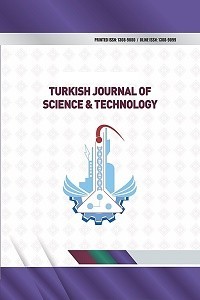ANN-Based MPPT Algorithm for Photovoltaic Systems
ANN-Based MPPT Algorithm for Photovoltaic Systems
Photovoltaic System, , Artificial Neural Networks-ANN, , Boost Converter, MPPT Algorithms, ,
___
- Larbes C, Cheikh S.M.A, Obeidi T, Zerguerras A. Genetic algorithms optimized fuzzy logic control for the maximum power point tracking in photovoltaic system. Renewable Energy 2009; 34: 2093–2100.
- Esram T, Chapman P.L. Comparison of photovoltaic array maximum power point tracking techniques. IEEE Transactions on Energy Conversion 2007; 22 (2): 439-449.
- Gupta A, Chauhan Y.K, Pachauri K. A comparative investigation of maximum power point tracking methods for solar PV systems. Solar Energy 2016; 136: 236-253.
- Belkaid A, Colak I, Kayisli K. Implementation of a modified P&O-MPPT algorithm adapted for varying solar radiation conditions. Electr Eng. 2017; 839–846..
- Chen P.C, Chen P.Y, Liu Y.H, Chen J.H, Luo Y.F. A comparative study on maximum power poit tracking techniques for photovoltaic generation systems operation under fast changing environments. Solar Energy 2015; 119: 261-276.
- Rezk H, Eltamaly A.M. A comprehensive comparison of different MPPT techniques for photovoltaic systems. Solar Energy 2015; 112: 1-11.
- Ahmed J, Salam Z. An enhanced adaptive P&O MPPT for fast and efficient tracking under varying environmental conditions. IEEE Transactions on Sustainable Energy 2018; 9 (3): 1487-1496.
- Başoğlu M.E, Çakır B. An improved incremental conductance based MPPT approach for PV modules. Turk J Elec Eng & Comp Sci. 2015; 23: 1687-1697.
- Radjai T, Rahmani L, Mekhilef S, Gaubert J.P. Implementation of a modified incremental conductance MPPT algorithm with direct control based on a fuzzy duty cycle change estimator using dSPACE. Solar Energy 2014; 110: 325-337.
- Bataineh K. Improved hybrid algorithms-based MPPT algorithm for PV system operating under severe weather conditions. IET Power Electronics 2018; 12 (4): 703-711.
- Celikel R, Gundogdu A. System identification-based MPPT algorithm for PV systems under variable atmosphere conditions using current sensorless approach. Int Trans Electr Energ Syst. 2020; e12433. https://doi.org/10.1002/2050-7038.12433.
- Celikel R. Speed Control of BLDC Using NARMA-L2 Controller in Single Link Manipulator. Balkan Journal of Electrical and Computer Engineering 2019; 7(2): 143-148.
- Karakaya B, Kaya T, Gulten A. FPGA-based ANN Design for Detecting Epileptic Seizure in EEG Signal. Balkan Journal of Electrical and Computer Engineering 2018; 6(2): 83-87.
- Deniz E. ANN-based MPPT algorithm for solar PMSM drive system fed by direct-connected PV array. Neural Comput & Applic. 2017; 28: 3061–3072.
- Elobaid L.M, Abdelsalam A.K, Zakzouk E.E. Artificial neural network-based photovoltaic maximum power point tracking techniques: a survey. IET Renewable Power Generation 2015; 9(8): 1043-1063.
- Kermadi Mostefa, Berkouk E.M. Artificial intelligence-based maximum power point tracking controllers for Photovoltaic systems: Comparative study. Renewable and Sustainable Energy Reviews 2017; 69: 369-386.
- Messalti S, Harrag A, Loukriz A. A new variable step size neural networks MPPT controller: Review, simulation and hardware implementation. Renewable and Sustainable Energy Reviews 2017; 68: 221-233.
- Çelik Ö, Teke A. A Hybrid MPPT method for grid connected photovoltaic systems under rapidly changing atmospheric conditions. Electric Power Systems Research 2017; 152: 194-210.
- Jyothy L.P, Sindhu M.R. An Artificial Neural Network based MPPT Algorithm For Solar PV System. In 2018 4th International Conference on Electrical Energy Systems (ICEES) 2018; 375-380.
- Kota V.R, Bhukya M.N. A novel global MPP tracking scheme based on shading pattern identification using artificial neural networks for photovoltaic power generation during partial shaded condition. IET Renewable Power Generation 2019; 13(10): 1647-1659.
- Ibrahim A.W, Jin X, Dai X, Sarhan M.A, Shafik M.B, Zhou H. Artificial Neural Network Based Maximum Power Point Tracking for PV System. In 2019 Chinese Control Conference (CCC) 2019; 6559-6564.
- Aydogmus O. Design of a solar motor drive system fed by a direct-connected photovoltaic array. Advances in Electrical and Computer Engineering 2012; 12 (3): 53-58.
- ISSN: 1308-9080
- Başlangıç: 2009
- Yayıncı: Fırat Üniversitesi
ANN-Based MPPT Algorithm for Photovoltaic Systems
A Control of SynRM using MPPT Algorithm and Effects of Advance Angle on Motor Performance
Güllü BOZTAŞ, Ömür AYDOĞMUŞ, Hanifi GÜLDEMİR
The Effect of Aggregate Size and Cure Conditions On The Engineering Properties of Concrete
Scenedesmus acutus’un Gelişim, Protein, Lipid ve Pigment Miktarı Üzerindeki Fotoperiyodun Etkisi
Nur AGIRMAN KAYMAZ, Ahmet Kadri CETİN
Design and Optimization of a PMSM for Obtaining High-Power Density and High-Speed
Güllü BOZTAŞ, Merve YILDIRIM, Ömür AYDOĞMUŞ
On the Robust Estimations of Location and Scale Parameters for Least Informative Distributions
Voltage Controlled Boost Converter-Inverter System for Photovoltaic Applications
